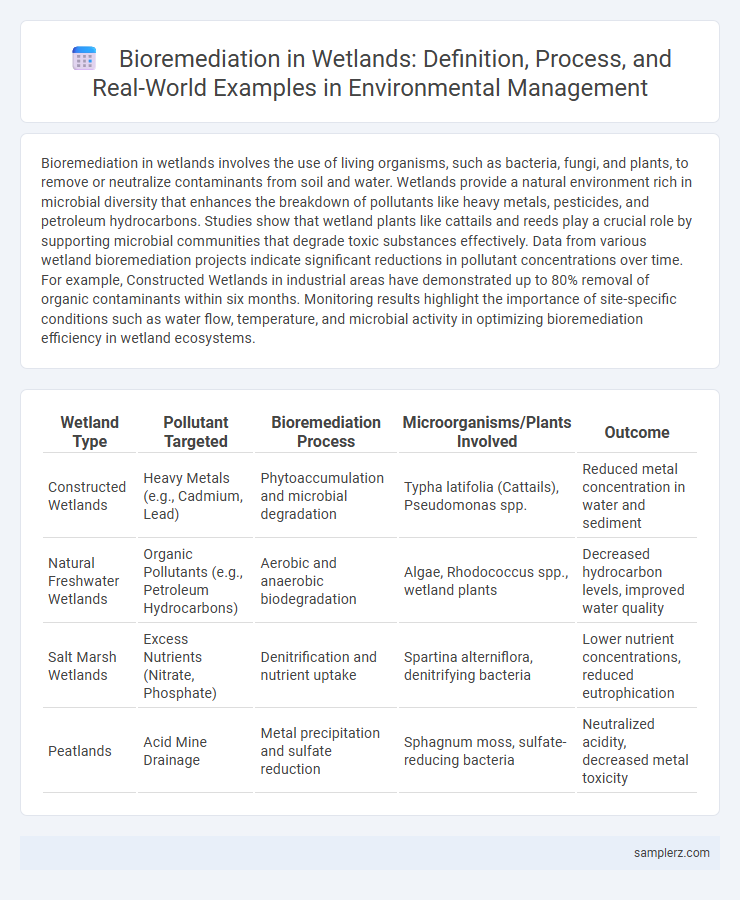Bioremediation in wetlands involves the use of living organisms, such as bacteria, fungi, and plants, to remove or neutralize contaminants from soil and water. Wetlands provide a natural environment rich in microbial diversity that enhances the breakdown of pollutants like heavy metals, pesticides, and petroleum hydrocarbons. Studies show that wetland plants like cattails and reeds play a crucial role by supporting microbial communities that degrade toxic substances effectively. Data from various wetland bioremediation projects indicate significant reductions in pollutant concentrations over time. For example, Constructed Wetlands in industrial areas have demonstrated up to 80% removal of organic contaminants within six months. Monitoring results highlight the importance of site-specific conditions such as water flow, temperature, and microbial activity in optimizing bioremediation efficiency in wetland ecosystems.
Table of Comparison
| Wetland Type | Pollutant Targeted | Bioremediation Process | Microorganisms/Plants Involved | Outcome |
|---|---|---|---|---|
| Constructed Wetlands | Heavy Metals (e.g., Cadmium, Lead) | Phytoaccumulation and microbial degradation | Typha latifolia (Cattails), Pseudomonas spp. | Reduced metal concentration in water and sediment |
| Natural Freshwater Wetlands | Organic Pollutants (e.g., Petroleum Hydrocarbons) | Aerobic and anaerobic biodegradation | Algae, Rhodococcus spp., wetland plants | Decreased hydrocarbon levels, improved water quality |
| Salt Marsh Wetlands | Excess Nutrients (Nitrate, Phosphate) | Denitrification and nutrient uptake | Spartina alterniflora, denitrifying bacteria | Lower nutrient concentrations, reduced eutrophication |
| Peatlands | Acid Mine Drainage | Metal precipitation and sulfate reduction | Sphagnum moss, sulfate-reducing bacteria | Neutralized acidity, decreased metal toxicity |
Introduction to Bioremediation in Wetlands
Bioremediation in wetlands leverages native microorganisms and plants to naturally degrade pollutants such as heavy metals, pesticides, and hydrocarbons. Wetlands like marshes and swamps provide anaerobic and aerobic environments that promote microbial activity essential for the breakdown of contaminants. This eco-friendly remediation technique enhances water quality and restores habitat functions while minimizing chemical and physical interventions.
Natural Processes Enhancing Wetland Bioremediation
Wetlands utilize natural biogeochemical processes such as microbial degradation and plant uptake to enhance bioremediation of pollutants like heavy metals and organic contaminants. The presence of rhizosphere bacteria accelerates the breakdown of hydrocarbons, while anaerobic conditions promote denitrification and phosphorus immobilization. These synergistic interactions within wetland ecosystems optimize the removal of contaminants, improving water quality and ecosystem health.
Microbial Communities and Pollutant Degradation
Microbial communities in wetlands play a crucial role in bioremediation by breaking down pollutants such as heavy metals, pesticides, and hydrocarbons through enzymatic processes. These diverse microorganisms, including bacteria, fungi, and archaea, metabolize contaminants into less toxic compounds, enhancing water quality and ecosystem health. Studies in various wetland ecosystems demonstrate significant reductions in pollutant concentrations due to microbial biodegradation pathways, highlighting their importance in natural and engineered remediation strategies.
Phytoremediation: Plants as Wetland Cleaners
Phytoremediation in wetlands utilizes plants such as cattails (Typha spp.) and bulrushes (Schoenoplectus spp.) to absorb and degrade pollutants, including heavy metals and excess nutrients, from the water and sediment. These wetland plants enhance the natural filtration process by stabilizing sediments, reducing contaminant bioavailability, and promoting microbial degradation. Studies confirm that phytoremediation effectively improves water quality and restores ecosystem health in contaminated wetland habitats.
Case Study: Oil Spill Cleanup in Constructed Wetlands
Constructed wetlands have effectively been utilized for oil spill cleanup by leveraging natural microbial communities that degrade hydrocarbons in contaminated water. A notable case study involved the restoration of a petroleum-contaminated wetland in Louisiana, where indigenous bacteria metabolized oil compounds, significantly reducing toxicity levels within months. These bioremediation processes not only restored water quality but also promoted the recovery of local flora and fauna, demonstrating wetlands' critical role in ecosystem rehabilitation.
Heavy Metal Removal Using Wetland Bioremediation
Wetland bioremediation effectively removes heavy metals such as lead, cadmium, and arsenic through natural processes involving plants like Typha latifolia and Phragmites australis, which absorb and accumulate metals in their tissues. Microbial communities within wetland sediments transform toxic metals into less bioavailable forms by redox reactions and precipitation mechanisms. Studies demonstrate that constructed wetlands can reduce heavy metal concentrations in wastewater by up to 80%, showcasing a sustainable approach to mitigating industrial and agricultural metal pollution.
Treatment of Agricultural Runoff in Wetlands
Wetlands serve as natural bioremediation systems by filtering agricultural runoff, reducing nutrient loads such as nitrogen and phosphorus through plant uptake and microbial processes. The dense vegetation and microbial communities in wetland soils break down pesticides and other organic contaminants, improving water quality before it reaches larger water bodies. These processes help prevent eutrophication and restore aquatic ecosystems impacted by intensive farming practices.
Role of Wetland Soils in Contaminant Breakdown
Wetland soils play a critical role in contaminant breakdown through their unique physicochemical properties and diverse microbial communities that facilitate bioremediation. These soils enhance the degradation of pollutants such as heavy metals, hydrocarbons, and pesticides by providing anaerobic and aerobic zones that support various biodegradation pathways. The presence of organic matter, redox gradients, and microbial enzymes in wetland sediments accelerates the transformation and immobilization of toxic substances, improving water quality and ecosystem health.
Challenges and Limitations of Wetland Bioremediation
Wetland bioremediation faces challenges such as fluctuating water levels that impact microbial activity essential for contaminant breakdown. Limited oxygen availability in saturated soils restricts aerobic degradation processes, reducing the efficiency of pollutant removal. Contaminant bioavailability and the presence of toxic substances can inhibit microbial populations, creating limitations for successful wetland bioremediation outcomes.
Future Prospects for Wetland-Based Bioremediation
Wetland-based bioremediation harnesses the natural microbial communities and plant species to degrade pollutants such as heavy metals, pesticides, and hydrocarbons, offering sustainable solutions for ecosystem restoration. Emerging technologies, including genetic engineering of microbes and real-time monitoring systems, enhance the efficiency and specificity of contaminant breakdown in wetland environments. Future prospects emphasize integrating these innovations with conservation practices to expand wetland restoration efforts and improve water quality on a global scale.

example of bioremediation in wetland Infographic
 samplerz.com
samplerz.com